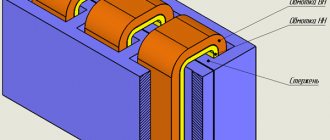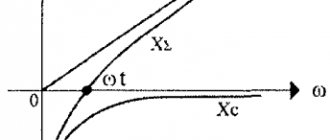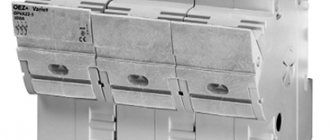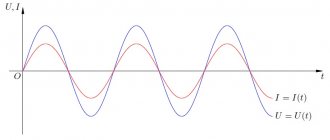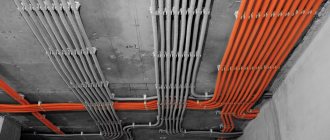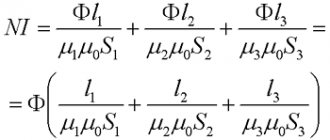The most significant part of an electrothermal installation is the heating element. The main component of indirect heating devices is a resistor with high resistivity. And one of the priority materials is chromium-nickel alloy. Since the resistance of nichrome wire is high, this material takes a leading place as a raw material for various types of electrothermal installations. Calculation of a heater made of nichrome wire is carried out in order to determine the size of the heating element.
Basic Concepts
In general, it is necessary to calculate a heating element made of nichrome using four calculations: hydraulic, mechanical, thermal and electrical. But usually calculations are carried out only in two stages: based on thermal and electrical indicators.
Thermal characteristics include:
- thermal insulation;
- heat efficiency;
- required heat transfer surface.
The main purpose of calculating nichrome is to determine the geometric dimensions of the heating resistance.
The electrical parameters of heaters are:
- supply voltage;
- power control method;
- power factor and electrical efficiency.
When choosing the supply voltage for heating devices, preference is given to that which poses minimal threat to animals and service personnel. The network voltage in agricultural installations is 380/200 volts with a current frequency of 50 Hertz. If electrical installations are used in particularly damp areas, or if there is an increased electrical hazard, the voltage should be reduced. Its value should not exceed 12, 24, 36 volts.
regulate the temperature and power of the heater in two ways:
- changing the voltage;
- changing the resistance value.
The most common way to change power is to turn on a certain number of sections of a three-phase installation. In modern heating installations, power is changed by adjusting the voltage using thyristors.
The calculation of the operating current is based on a tabular relationship that relates the current load on a nichrome conductor, its cross-sectional area and temperature.
Tabular data were compiled for nichrome wire, which was stretched in air without taking into account oscillations and vibrations at a temperature of 20 °C.
In order to move to real conditions, it is necessary to use correction factors in the calculations.
Calculation algorithm for single-phase installations
Calculation of a nichrome spiral should be carried out in stages, using initial information about the heater: the required power and brand of nichrome.
Power of one section:
Рс = Р/ (mn)
P—installation power, W;
m - number of phases, for single-phase m = 1;
n is the number of sections in one phase, for installations with a capacity of about 1 kW n = 1.
Operating current of one heater section:
Ic = P s/(Un)
U - mains voltage, for single-phase installations U = 220 V
Design wire temperature:
θр = θd/(Km Ks)
θd - permissible operating temperature, selected from Table 1 depending on the material, °C.
Table 1 - Material parameters for electric heaters.
| Material | Resistivity at 20 °C, x10-6Ω m | Temperature coefficient of resistance, x10— 6 °C -1 | Permissible operating temperature, °C | Melting point, °C |
| Double nichrome (Х20Н80-Н) | 1,1 | 16,5 | 1200 | 1400 |
| Triple nichrome (Х15Н60-Н) | 1,1 | 16,3 | 1100 | 1390 |
Km is the installation coefficient, selected from Table 2 depending on the design.
Table 2 - Installation coefficient for some types of heater designs in a quiet air flow.
| Heater design | Km |
| Wire when placed horizontally | 1,0 |
| Spiral made of wire without thermal insulation | 0,8 — 0,9 |
| Wire spiral on a fireproof frame | 0,7 |
| Wire on fireproof frame | 0,6 — 0,7 |
| Heating resistances between two layers of thermal insulation | 0,5 |
| Heating resistors with good thermal insulation | 0,3 — 0,4 |
The role of the installation coefficient is that it makes it possible to take into account the increase in heater temperature in real conditions compared to the data in the reference table.
Kc is the environmental coefficient, determined from Table 3.
Table 3 - Correction factor for some environmental conditions.
| Environmental conditions | KS |
| A spiral of wire in an air flow with a speed of movement, m/s | |
| 3 | 1,8 |
| 5 | 2,1 |
| 10 | 3,1 |
| Heating element in still water | 2,5 |
| Heating element in water flow | 3,0−3,5 |
The environmental coefficient corrects for improved heat transfer due to environmental conditions. Therefore, the actual calculation results will differ slightly from the table values.
Diameter d, mm and cross-sectional area S, mm 2 are selected according to operating current and design temperature from Table 4
Table 4 - Permissible load on nichrome wire at 20 °C, suspended horizontally in calm air.
Wire length of one section:
L = (U f2S*10-6)/(ρ 20 [1+α(θ р -20)] Рс x103)
ρ 20 - resistivity at a temperature of 20 °C, selected from table 1;
α is the temperature coefficient of resistance, determined from the corresponding column in Table 1.
Spiral diameter:
D = (6…10) d, mm.
Determine the spiral pitch:
h = (2…4) d, mm
The spiral pitch affects work performance. At higher values, heat transfer increases.
Number of spiral turns
W = (lx103)/ (√h2+(πD)2)
Spiral length:
L = h W x10-3
If the purpose of the wire heater is to increase the temperature of the liquid, the operating current is increased by 1.5 times the calculated value. In the case of calculating a heater with a closed type, it is recommended to reduce the operating current by 1.2 times.
Application and calculation of an electric spiral made of nichrome
- July 19, 2022 at 09:18
- 2750
A nichrome spiral is a heating element in the form of a wire, rolled with a screw for compact placement. The wire is made of nichrome , a precision alloy whose main components are nickel and chromium. The “classic” composition of this alloy is 80% nickel, 20% chromium. The composition of the names of these metals formed the name that denotes the group of chromium-nickel alloys - “nichrome”.
The most famous brands of nichrome are X20N80 and X15N60 . The first of them is close to the “classics”. It contains 72-73% nickel and 20-23% chromium. The second is designed to reduce the cost and increase the machinability of the wire. nickel and chromium in it are reduced - to 61% and to 18%, respectively. But the amount of iron has been increased - 17-29% versus 1.5 for X20N80.
Based on these alloys, modifications with higher survivability and resistance to oxidation at high temperatures were obtained. These are brands X20N80-N (-N-VI) and X15N60 (-N-VI). They are used for heating elements in contact with air. Recommended maximum operating temperature – from 1100 to 1220 °C
Application of nichrome wire
The main quality of nichrome is its high resistance to electric current. It determines the applications of the alloy. Nichrome spiral is used in two qualities - as a heating element or as a material for electrical resistance of electrical circuits.
For heaters, an electric spiral made of X20N80-N and X15N60-N alloys is used. Application examples:
- household thermoreflectors and fan heaters;
- Heating elements for household heating devices and electric heating;
- heaters for industrial furnaces and thermal equipment.
Alloys Kh15N60-N-VI and Kh20N80-N-VI, produced in vacuum induction furnaces, are used in industrial equipment of increased reliability.
A spiral made of nichrome grades X15N60, X20N80 , X20N80-VI is distinguished by the fact that its electrical resistance changes little with temperature changes. It is used to make resistors, connectors for electronic circuits, and critical parts of vacuum devices.
How to wind a spiral from nichrome
A resistive or heating coil can be made at home. To do this, you need nichrome wire of a suitable grade and the correct calculation of the required length.
The calculation of a nichrome spiral is based on the resistivity of the wire and the required power or resistance, depending on the purpose of the spiral. When calculating power, you need to take into account the maximum permissible current at which the coil heats up to a certain temperature.
Temperature accounting
For example, a wire with a diameter of 0.3 mm at a current of 2.7 A will heat up to 700 °C, and a current of 3.4 A will heat it to 900 °C. There are reference tables for calculating temperature and current. But you still need to take into account the operating conditions of the heater. When immersed in water, heat transfer increases, then the maximum current can be increased by up to 50% of the calculated one. A closed tubular heater, on the contrary, impairs heat dissipation. In this case, the permissible current must be reduced by 10-50%.
The intensity of heat removal, and therefore the temperature of the heater, is affected by the pitch of the spiral winding . Densely spaced coils generate more heat, while a larger pitch increases cooling. It should be taken into account that all tabular calculations are given for a heater located horizontally. When the angle to the horizon changes, the heat removal conditions worsen.
Calculation of the resistance of a nichrome spiral and its length
Having decided on the power, we proceed to calculate the required resistance. If the determining parameter is power, then first we find the required current using the formula I=P/U. Having the current strength, we determine the required resistance. To do this, we use Ohm's law: R=U/I.
The notations here are generally accepted:
- P – allocated power;
- U is the voltage at the ends of the spiral;
- R – spiral resistance;
- I – current strength.
The calculation of the resistance of nichrome wire is ready. Now let's determine the length we need. It depends on the resistivity and wire diameter. You can make a calculation based on the resistivity of nichrome: L=(Rπd2)/4ρ. Here:
- L – required length;
- R – wire resistance;
- d – wire diameter;
- ρ – resistivity of nichrome;
- π – constant 3.14.
But it’s easier to take ready-made linear resistance from the tables of GOST 12766.1-90. You can also take temperature corrections there if you need to take into account changes in resistance when heated. In this case, the calculation will look like this: L=R/ρld, where ρld is the resistance of one meter of wire having a diameter d.
Spiral winding
Now let's make a geometric calculation of a nichrome spiral . We have selected the wire diameter d, the required length L has been determined, and we have a rod with diameter D for winding. How many turns do you need to make? The length of one turn is: π(D+d/2). Number of turns – N=L/(π(D+d/2)).
The calculation is completed.
In practice, rarely does anyone wind their own wire for a resistor or heater. It’s easier to buy a nichrome spiral with the required parameters and, if necessary, separate the required number of turns from it.
Source: https://www.elec.ru/articles/elektricheskaja-spiral-iz-nikhroma/
Classification of heaters by temperature
Heaters are divided into five classes according to the maximum permissible temperature:
- 200°C . In this temperature range, tubular electric heaters are most widely used. In order to maintain the optimal temperature in the workspace, when installing heating elements, it is necessary to pay attention to their correct location.
- From 200 to 400°C . Tape heaters are used. To create the required temperature in the working chamber, its entire perimeter is covered.
- From 400 to 600°C . The material for the heaters should only be a high-resistance resistive element. Common ones are constantan, fechral, nichrome. In order to ensure the required temperature, the heater must be open to air access. Therefore it is located inside or outside the tube.
- From 600 to 1250°C . Old style stoves use nichrome. But in this temperature range it is significantly inferior to an alloy of aluminum, iron and chromium (fechral). Therefore, in more modern models of stoves, nichrome is replaced with fechral.
- From 1250 to 1700° C. High temperature heaters are made from molybdenum disilicide, silicon carbide. The main disadvantage of heaters is their scarcity and high cost.
How to calculate the length of nichrome wire
In the practice of a home craftsman, one has to repair or construct heating devices. These can be various ovens, heaters, soldering irons and cutters. Most often, spirals or nichrome wire are used for this. The main task is to determine the length and cross-section of the material. In this article we will talk about how to calculate the length of a nichrome wire or spiral based on power, resistance and temperature.
Basic information and brands of nichrome
Nichrome is an alloy of nickel and chromium with additions of manganese, silicon, iron, and aluminum. The parameters of this material depend on the specific ratio of substances in the alloy, but on average they lie within the limits:
- electrical resistivity - 1.05-1.4 Ohm*mm2/m (depending on the alloy grade);
- temperature coefficient of resistance - (0.1-0.25)·10−3 K−1;
- operating temperature - 1100 °C;
- melting point - 1400°C;
In tables, resistivity is often given in µOhm*m (or 10-6 Ohm*m) - the numerical values are the same, the difference is in dimension.
Currently, there are two most common brands of nichrome wire:
- Х20Н80. It consists of 74% nickel and 23% chromium, as well as 1% each of iron, silicon and manganese. Conductors of this brand can be used at temperatures up to 1250 ᵒС, melting point – 1400 ᵒС. It also has increased electrical resistance. The alloy is used for the manufacture of elements of heating devices. Specific resistance – 1.03-1.18 µOhm m;
- Х15Н60. Composition: 60% nickel, 25% iron, 15% chromium. Operating temperature no more than 1150 ᵒC. Melting point – 1390 ᵒС. Contains more iron, which increases the magnetic properties of the alloy and increases its anti-corrosion resistance.
Troubleshooting Settings
The highest probability of failure of electric heaters is due to oxidation of the surface of the heating resistance.
Factors that influence the rate of heater destruction:
- working temperature;
- environmental conditions in which the heater operates;
- switching frequency.
Due to the fact that electric heating installations operate in excess of the permissible values of these parameters, the most frequent breakdowns occur: burning of contacts, violation of the mechanical strength of nichrome wire.
Repair of a nichrome heating element is carried out by soldering or twisting.


